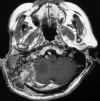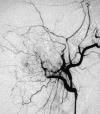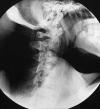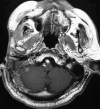Efficacy of selective transarterial chemotherapy using a port systemfor angiosarcomas of the face and scalp
- PMID: 20557754
- PMCID: PMC3313716
- DOI: 10.1177/159101990801400204
Efficacy of selective transarterial chemotherapy using a port systemfor angiosarcomas of the face and scalp
Abstract
Angiosarcoma is a rare, highly malignant tumor with a poor clinical outcome. From January 2004 to September 2005, we advocated transarterial chemotherapy using a port system for four patients with angiosarcomas of the face and scalp. A heparin coated ANTHRON P-Ucatheter was introduced into the feeding artery. The proximal part of the P-U catheter was connected to the port system and buried in subcutaneous tissue. The amount of chemotherapeutic drug applied using the port system was almost the same as the conventional intravenous dose. Paclitaxel was the standard agent, at 50-100 mg/diluted in 15-30 ml of physiological saline fluid slowly injected over 0.5-1 hour. For immunotherapy where appropriate, r-IL2 was mainly used at a dose of 70.000U/ diluted in 5 ml of physiological saline fluid injected into the port system over 30 seconds. This was continued for two to three weeks (five days/week) until recognition of a disappearance of the tumor. Macroscopic size reduction of the tumor was achieved in three out of the four cases. One case could not be evaluated because of eruptions induced by immunotherapy. Unfortunately two patients died after placement of port system, but the other two are still alive and are enjoying useful lives. Transarterial infusion chemotherapy using such a port system may be particularly effective for angiosarcoma in the early stages because small lesions with limited invasion mean a small territory of blood supply to be covered, and useful life was possible because the port system embedded in subcutaneous tissue allows treatment in an out-patient clinic.
Figures






Similar articles
-
[Laparoscopic peritoneal dialysis catheter implantation in peritoneal chemotherapy for gastric cancer with peritoneal metastasis].Zhonghua Wei Chang Wai Ke Za Zhi. 2019 Aug 25;22(8):774-780. doi: 10.3760/cma.j.issn.1671-0274.2019.08.013. Zhonghua Wei Chang Wai Ke Za Zhi. 2019. PMID: 31422617 Chinese.
-
[A safe and simple method of percutaneous transfemoral implantation of a port-catheter access system for hepatic artery chemotherapy infusion].Gan To Kagaku Ryoho. 2001 Oct;28(11):1573-7. Gan To Kagaku Ryoho. 2001. PMID: 11707983 Japanese.
-
Paclitaxel in patients with advanced angiosarcomas of soft tissue: a retrospective study of the EORTC soft tissue and bone sarcoma group.Eur J Cancer. 2008 Nov;44(16):2433-6. doi: 10.1016/j.ejca.2008.07.037. Epub 2008 Sep 2. Eur J Cancer. 2008. PMID: 18771914
-
Palliative Chemotherapy: Does It Only Provide False Hope? The Role of Palliative Care in a Young Patient With Newly Diagnosed Metastatic Adenocarcinoma.J Adv Pract Oncol. 2017 May-Jun;8(4):382-386. Epub 2017 May 1. J Adv Pract Oncol. 2017. PMID: 30018843 Free PMC article. Review.
-
Metastatic Angiosarcoma of the Scalp Presenting with Cystic Lung Lesions: A Case Report and Review of Cystic Lung Diseases.Perm J. 2018;22:17-168. doi: 10.7812/TPP/17-168. Perm J. 2018. PMID: 30005733 Free PMC article. Review.
References
-
- William M, Charles M, et al. Cutaneous angiosarcoma. Am J Clin Oncol. 2006;29:524–528. - PubMed
-
- Masuzawa M. A remedy strategy for hemangiosarcom. . Jpn Dermatol . 2003;113:1523–1533.
-
- Mark RJ, Poen JC, et al. Angiosarcoma: a report of 67 patients and a review of the literature. Cancer. 1996;77:2400–2406. - PubMed
-
- Skubitz KM, Haddad PA, et al. Paclitaxel and pegylated-liposomal doxorubicin are both active in angiosarcoma. . Cancer. 2005;104:361–366. - PubMed
-
- Bong AB, Bonnekoh B, et al. Treatment of scalp angiosarcoma by controlled perfusion of A, carotis externa with pegylated liposomal doxorubicin and intralesional application of pegylated interferon alfa. J Am Acad Dermatol. 2005;52:20–23. - PubMed
LinkOut - more resources
Full Text Sources

